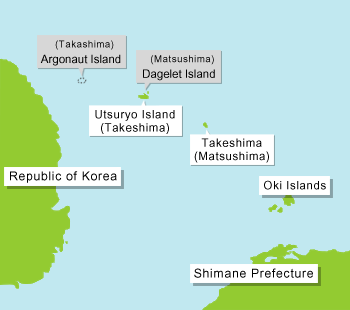10:31 PM
1. Recognition of Takeshima
(Recognition of Takeshima in Japan)

- The group of islands currently called Takeshima were once known as "Matsushima," and the island now called Utsuryo used to be known as "Takeshima" or "Isotakeshima." Although the names of Takeshima and Utsuryo Island were temporarily confused due to errors in the placement of Utsuryo Island by European explorers and others, it can be confirmed from a variety of maps and documents that Japan has long recognized the existence of "Takeshima" and "Matsushima." For example, the Kaisei Nippon Yochi Rotei Zenzu (Revised Complete Map of Japanese Land and Roads - first published in 1779) by Sekisui Nagakubo, the most prominent published cartographic projection of Japan, accurately show the locations of Utsuryo Island and Takeshima between the Korean Peninsula and the Oki Islands.
- In 1787, a French explorer Jean-Francois de Galaup, Comte de La Perouse reached Utsuryo Island and named the island "Dagelet." After that, a British explorer James Colnett also found Utsuryo Island in 1789 and named the island "Argonaut." However, as there was some discrepancy in their latitudinal and longitudinal positioning of Utsuryo Island between their measurements, resultantly Utsuryo Island was apparently illustrated as two separate islands on maps subsequently produced in Europe.
- In 1840, a doctor named Philipp Franz von Siebold, who had worked on the island of Dejima in Nagasaki, created a map of Japan. He had learned from various Japanese documents and maps that two groups of islands, "Takeshima" (current Utsuryo Island) and "Matsushima" (current Takeshima), were located from the west to the east between the Oki Islands and the Korean Peninsula. At the same time, he also knew that there were two groups of islands named "Argonaut" and "Dagelet" located from the west to the east on European maps. Consequently, Siebold described "Argonaut" as "Takashima" and "Dagelet" as "Matsushima" on his map. This caused further confusion by giving the different name "Matsushima" to Utsuryo Island, which had consistently been called "Takeshima" or "Isotakeshima" until then.
- Thus, the long-held knowledge on "Takeshima" and "Matsushima" in Japan confusingly coexisted with the names that subsequently came from the Western world. In the middle of such confusion, Japanese who could see "Matsushima" in the distance requested the government to develop the island. The government implemented a field study in 1880 in order to clarify the relationship among the different names of the islands, and confirmed that the island referred to as "Matsushima" in the request was actually Utsuryo Island.
- Based on the above-mentioned process, Utsuryo Island came to be called "Matsushima," which raised the question of what to call the current Takeshima. To resolve this issue, the Japanese Government, after hearing opinions from Shimane Prefecture, changed the traditional names and officially named the current Takeshima as such in 1905.
(Recognition of Takeshima in the Republic of Korea)
- There is no evidence showing that the ROK has long recognized the existence of Takeshima. For example, the ROK claims that, based on descriptions in old Korean texts including "Samguksagi (History of the Three Kingdoms: 1145)," "Sejong Sillok Jiriji (Geographical Appendix to the Veritable Records of King Sejong: 1454)," "Sinjeung Dongguk Yeoji Seungnam (A Revised Edition of the Augmented Survey of the Geography of Korea: 1531)," "Dongguk Munheonbigo (Study of Korean Documents: 1770)," "Mangi Yoram (Handbook of State Affairs: 1808)" and "Jeungbo Munheonbigo (Augmented Study of Documents: 1908)," Koreans had long been aware of the existence of the two islands of Utsuryo and Usan, and that this "Usan Island" is the current Takeshima.
- However, whereas the "History of the Three Kingdoms" contains a description that Utsuryo Island which belonged to Usan Country became a part of Silla in 512, there is no description of "Usan Island." Meanwhile, in other ancient Korean documents, "Usan Island" is described as a place where many people lived and large bamboo was cultivated, which does not represent the realities of Takeshima and sounds more like Utsuryo Island.
- The ROK claims that "Usan Island" is what the Japanese called Matsushima (now Takeshima) based on the description in "Yeojiji (Record of Geography: 1656)" cited in the "Study of Korean Documents," "Augmented Study of Documents" and "Handbook of State Affairs." On the other hand, some study criticizes that the original text in the "Record of Geography" indicates that "Usan Island" and Utsuryo Island are two names for the same island and that the description in the documents such as the "Study of Korean Documents" did not directly or accurately quote from the "Record of Geography." Such study points out that the descriptions in those documents were copied from "Ganggyego (Study of National Boundary)" (part of "Ganggyeji -Record of National Boundary: 1756"), which had uncritically copied a less reliable statement by An Yong-bok.
- In the map attached to "A Revised Edition of the Augmented Survey of the Geography of Korea," Utsuryo Island and "Usan Island" are described as two separate islands. If, as the ROK claims, "Usan Island" were the current Takeshima, it should have been described as a much smaller island than Utsuryo Island and located east of Utsuryo Island. However, the "Usan Island" in this map is illustrated as being roughly of the same size as Utsuryo Island, and situated between the Korean Peninsula and Utsuryo Island (west of Utsuryo Island), which shows that the island does not exist.










.jpg)
.jpg)

.jpg)





0 comments:
Post a Comment
Note: Only a member of this blog may post a comment.